Schlechta K. Nonmonotonic Logics: Basic Concepts, Results, and Techniques
Подождите немного. Документ загружается.


6.1. INHERITANCE DIAGRAMS
197
Diagram6.21
Y
'U-4 .......... Z
X
2;
(a) length(a)
> 1 and
(b)
Case 1, cr is positive: either x 74 y E F or there is u such that ~ : x-.- --~ u ~ y
and a positive pp. r : X...-~ Z.-. ~uforsomez such that (1) E ~ ~-, (2)
z74yer.
Case 2, cr is negative: analogous, i.e. either x -+ y E F or there is u such that
: z--. --+ u O Y and a positive pp. r : x-.- ~ z-.. ~ u for some z such that
(1) ED~,(2)z-~y~r.
2) Validity of Paths in Extensions
Case I (Direct Links): If cr is a direct link in F, then E ~ or.
Case II: Potential
paths of
length > 1:
Let <x,y>+:= { <T:x .... ,u,u~y>: (a) v is a positive pp., (b) E~r,
(c) u --~ y C F, (d) r o u + y is not precluded in E },
and
< x,y
>- := { <
r:x...--~ u,u 74 y
>: (a) r is a positive pp., (b) E ~ r, (c)
u 74 y ~ I', (d) r o u 74 y is not precluded in E }.
Case II.l: < x,y >+=< z,y >-= ~: E is left unchanged, it contains no valid
paths from x to y.
Case II.2: < x, y >+r O, < x, y >-= (~: We add to E all paths r o u --~ y with
< r, u ---* y >E< x, y >+ as valid.
Case II.3: <
x,y
>+= ~, <
x,y
>-r (~: We add to E all paths r o u 74 y with
< r,u 74 y >C< x,y >- as valid.
Case II.4: < x, y >+-r r < x, y >-r ~: The construction of E will split into two
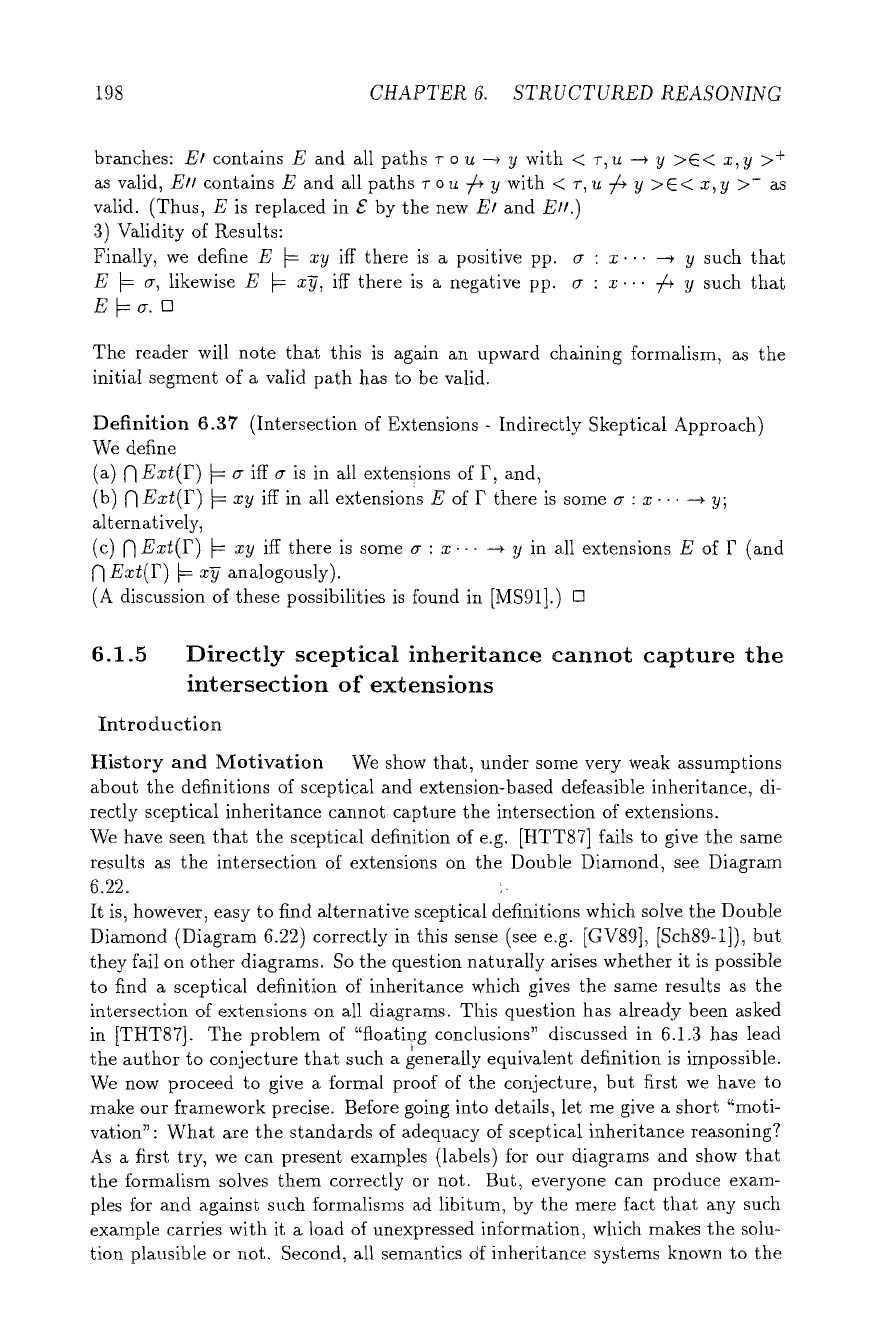
198 CHAPTER 6. STRUCTURED REASONING
branches: Et contains E and all paths r o u ~ y with < T,u --~ y >E< x,y >+
as valid, Eli contains E and all paths Tou 74 y with < r,u 74 y >C< x,y >- as
valid. (Thus, E is replaced in g by the new E! and Ett.)
3) Validity of Results:
Finally, we define E ~ xy iff there is a positive pp. c~ : z... ~ y such that
E ~ e, likewise E ~ x~, iffthereis a negative pp. ~ : z... 74 y such that
E Vc~. o
The reader will note that this is again an upward chaining formalism, as the
initial segment of a valid path has to be valid.
Definition 6.37 (Intersection of Extensions - Indirectly Skeptical Approach)
We define
(a) N Ezt(r) b ~
iff ~ is in all extensions of r, and,
(b) FIExt(F) ~ zy iff in all extensions E of I" there is some c~: x-.. + y;
alternatively,
(c) n Ext(F) ~ xy iff there is some ~: z..- --+ y in all extensions E of F (and
I-1 Ext(F) ~ zy analogously).
(A discussion of these possibilities is found in [MS91].) []
6.1.5
Directly sceptical inheritance cannot capture the
intersection of extensions
Introduction
History and Motivation We show that, under some very weak assumptions
about the definitions of sceptical and extension-based defensible inheritance, di-
rectly sceptical inheritance cannot capture the intersection of extensions.
We have seen that the sceptical definition of e.g. [HTT87] fails to give the same
results as the intersection of extensions on the Double Diamond, see Diagram
6.22. :
It is, however, easy to find alternative sceptical definitions which solve the Double
Diamond (Diagram 6.22) correctly in this sense (see e.g. [GV89], [Sch89-1]), but
they fail on other diagrams. So the question naturally arises whether it is possible
to find a sceptical definition of inheritance which gives the same results as the
intersection of extensions on all diagrams. This question has already been asked
in [THT87]. The problem of "floating conclusions" discussed in 6.1.3 has lead
the author to conjecture that such a ~enerally equivalent definition is impossible.
We now proceed to give a formal proof of the conjecture, but first we have to
make our framework precise. Before going into details, let me give a short "moti-
vation": What are the standards of adequacy of sceptical inheritance reasoning?
As a first try, we can present examples (labels) for our diagrams and show that
the formalism solves them correctly or not. But, everyone can produce exam-
ples tbr and against such formalisms ad libitum, by the mere fact that any such
example carries with it a load of unexpressed information, which makes the solu-
tion plausible or not. Second, all semantics df inheritance systems known to the

Y
Y
o~
k~
C~
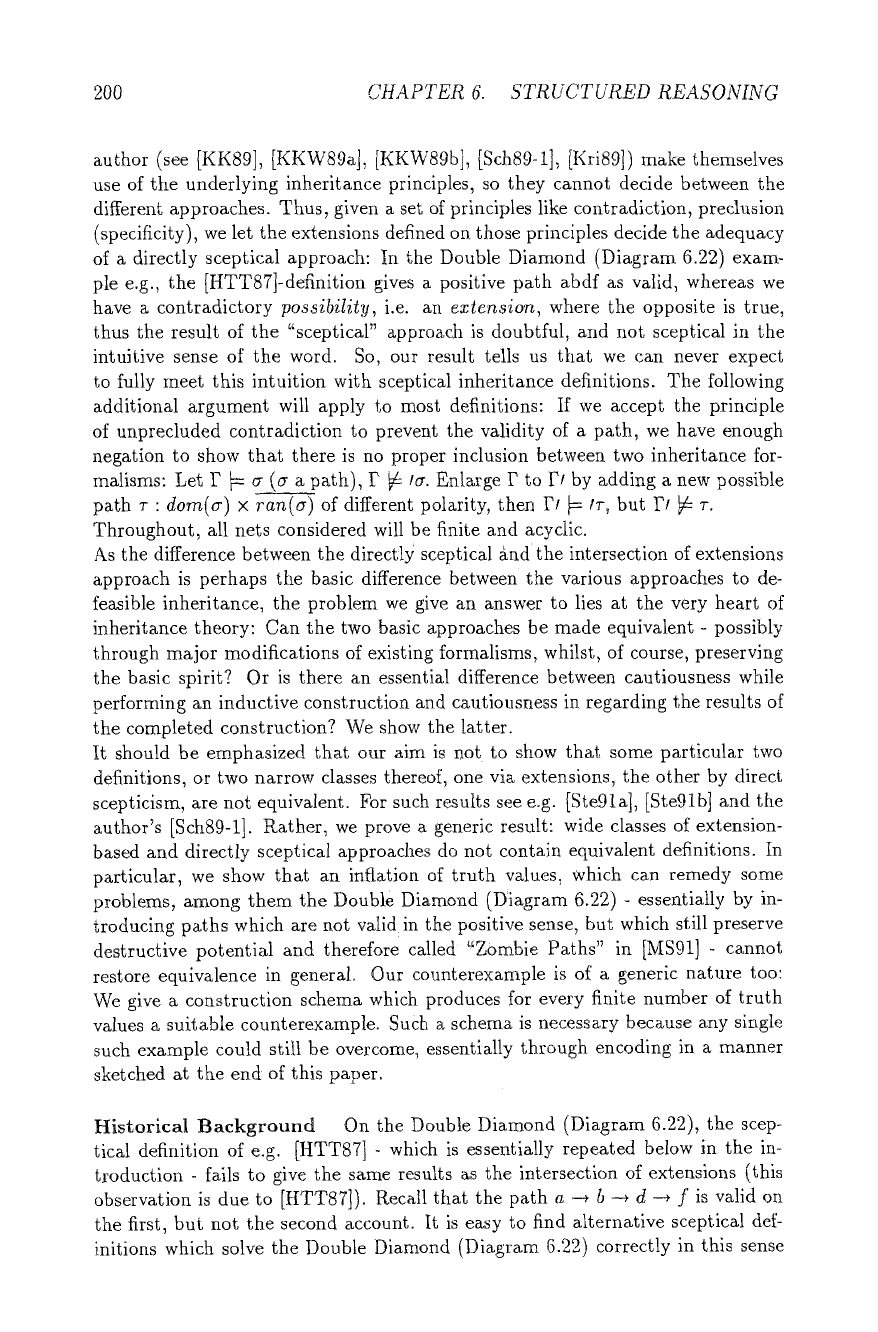
200 CHAPTER 6. STRUCTURED REASONING
author (see [KK89], [KKW89a], [KKW89b], [Sch89-1], [Kri89])make themselves
use of the underlying inheritance principles, so they cannot decide between the
different approaches. Thus, given a set of principles like contradiction, preclusion
(specificity), we let the extensions defined on those principles decide the adequacy
of a directly sceptical approach: In the Double Diamond (Diagram 6.22) exam-
pie e.g., the [HTT87]-definition gives a positive path abdf as valid, whereas we
have a contradictory possibility, i.e. an extension, where the opposite is true,
thus the result of the "sceptical" approach is doubtful, and not sceptical in the
intuitive sense of the word. So, our result tells us that we can never expect
to fully meet this intuition with sceptical inheritance definitions. The following
additional argument will apply to most definitions: If we accept the principle
of unprecluded contradiction to prevent the validity of a path, we have enough
negation to show that there is no proper inclusion between two inheritance for-
malisms: Let F ~ cr (c; a path), P ~ tc~. Enlarge P to Pf by adding a new possible
path r : dom(rr) x ran(c) of different polarity, then Pt ~ tr, but D }6 r.
Throughout, all nets considered will be finite and acyclic.
As the difference between the directly sceptical &nd the intersection of extensions
approach is perhaps the basic difference between the various approaches to de-
feasible inheritance, the problem we give an answer to lies at the very heart of
inheritance theory: Can the two basic approaches be made equivalent - possibly
through major modifications of existing formalisms, whilst, of course, preserving
the basic spirit? Or is there an essential difference between cautiousness while
performing an inductive construction and cautiousness in. regarding the results of
the completed construction? We show the latter.
It sho,dd be emphasized that our aim is not to show that some particular two
definitions, or two narrow classes thereof, one via extensions, the other by direct
scepticism, are not equivalent. For such results see e.g. [Ste91a], [Ste91b] and the
author's [Sch89-1]. Rather, we prove a generic result: wide classes of extension-
based and directly sceptical approaches do not contain equivalent definitions. In
particular, we show that an inflation of truth values, which can remedy some
problems, among them the Double Diamond (Diagram 6.22) - essentially by in-
troducing paths which are not valid in the positive sense, but which still preserve
destructive potential and therefore called "ZOmbie Paths" in [MS91] - cannot
restore equivalence in general. Our counterexample is of a generic nature too:
We give a construction schema which produces for every finite number of truth
values a suitable counterexample. Such a schema is necessary because any single
such example could still be overcome, essentially through encoding in a manner
sketched at the end of this paper.
Historical Background On the Double Diamond (Diagram 6.22), the scep-
tical definition of e.g. [HTT871 - which is essentially repeated below in the in-
troduction - fails to give the same results as the intersection of extensions (this
observation is due to [HTT87]). Recall that the path a --+ 6 --+ d --* f is valid on
the first, but not the second account. It is easy to find alternative sceptical def-
initions which solve the Double Diamond (Diagram 6.22) correctly in this sense

6.1. INHERITANCE DIAGRAMS
201
Diagram 6.23
i
h
a
g
(see e.g. [GV89], [Sch89-1]); but they fail on other diagrams. So the question
naturally arises whether it is possible to find a sceptical definition of inheritance
which gives the same results as the intersection of extensions on all diagrams. This
question has already been asked in [THT87], and also in [GV89]. The diagram of
alternating preclusions (Diagram 6.23 for off-path preclusion, and Diagram 6.10
for on-path preclusion) led the author to the conjecture made precise and proved
below as Theorem 6.40, that no sceptical definition of inheritance, however mod-
ified, can ever give the same results as the intersection of extensions approach on
all diagrams.
(In our proof of Theorem 6.40 below, we will use another technique - essentially
disjunction instead of negation - to keep the assumptions about the definition
of sceptical inheritance weak.) The importance of these diagrams is that (e.g.
in Diagram 6.23) we have a Nixon-Diamond in
a ~ d -+ 9/a ~ e 74 9:
In an
extensions approach, we can decide here for the positive or the negative possibility.
If we take the positive choice, a --~ d --+ g --* 1 --* k and
1 74 rn
is a preclusion of
a --~ i --~ k --* rn, but the other possible preclusion a ~ f --~ h --* i and h 74 k
is itself precluded by a --+ d --4 9 ~ f and g 7/4 h. On the other hand, in the
negative choice, a -~ d --~ g does not exist, so neither does a ~ d --~ 9 --~ l ~ k,
but a ~ f ~ h ~ i with h 74 k is now a preclusion. So, in either choice
(=
cztensio'n)
the path a --* i --~ k -+ rn is destroyed by preclusion, but not by
a common one. Consequently, in all extensions, we do not accept a positive path
from a to m, in one extension, we have a valid negative path from a via l to rn, in
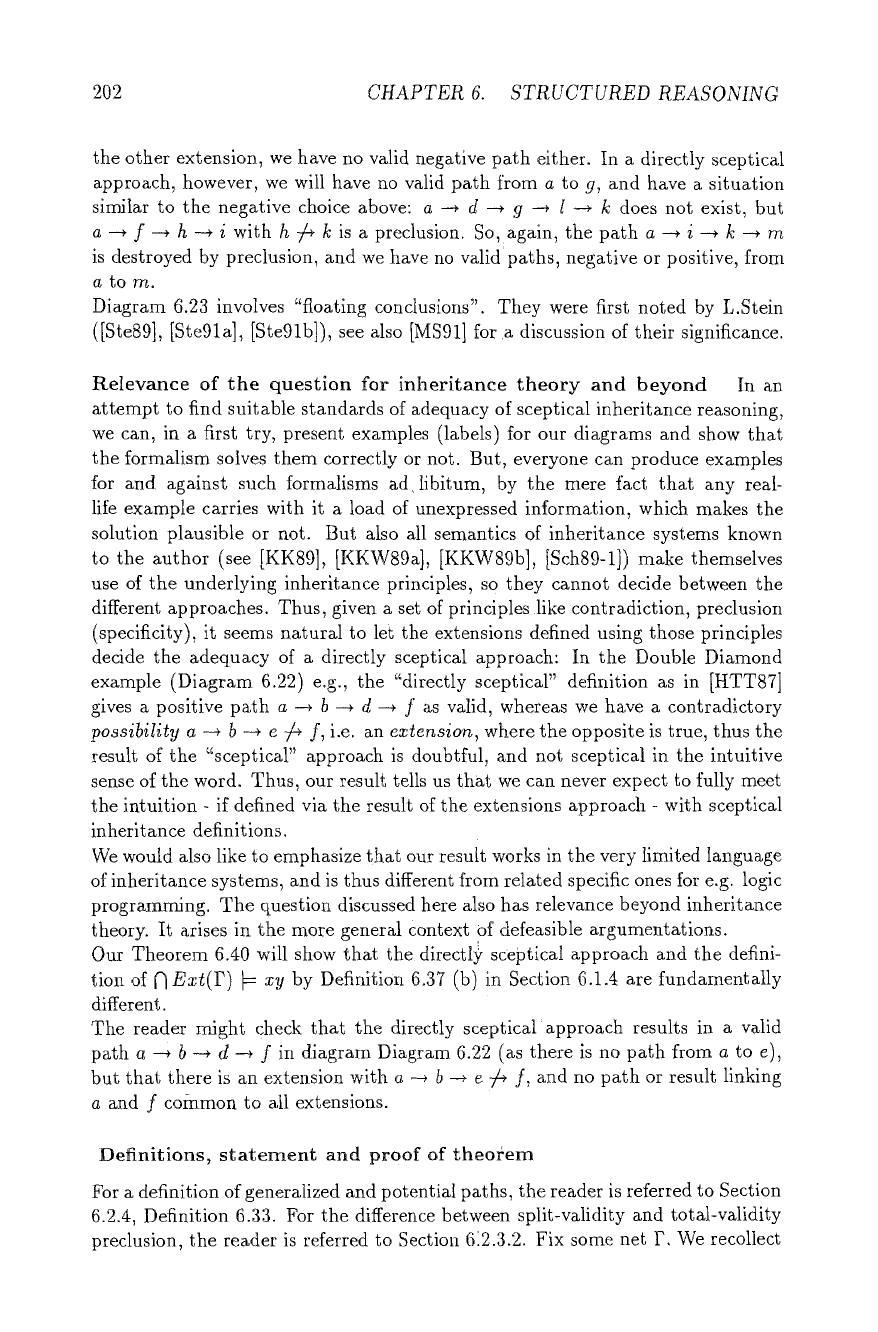
202
CHAPTER 6. STRUCTURED REASONING
the other extension, we have no valid negative path either. In a directly sceptical
approach, however, we will have no valid path from a to 9, and have a situation
similar to the negative choice above: a --* d --~ g --+ I --~ k does not exist, but
a ~ f ~ h ~ i with h 74 k is a preclusion. So, again, the path a --+ i ~ k ~ m
is destroyed by preclusion, and we have no valid paths, negative or positive, from
a tom.
Diagram 6.23 involves "floating conclusions". They were first noted by L.Stein
([Ste89], [SteDla], [Ste91b]), see also [MSD1] for a discussion of their significance.
Relevance of the question for inheritance theory and beyond In an
attempt to find suitable standards of adequacy of sceptical inheritance reasoning,
we can, in a first try, present examples (labels) for our diagrams and show that
the formalism solves them correctly or not. But, everyone can produce examples
for and against such formalisms ad libitum, by the mere fact that any real-
life example carries with it a load of unexpressed information, which makes the
solution plausible or not. But also all semantics of inheritance systems known
to the author (see [KK89], [I(KW89a], [KKW89b], [Sch89-1]) make themselves
use of the underlying inheritance principles, so they cannot decide between the
different approaches. Thus, given a set of principles like contradiction, preclusion
(specificity), it seems natural to let the extensions defined using those principles
decide the adequacy of a directly sceptical approach: In the Double Diamond
example (Diagram 6.22) e.g., the "directly sceptical" definition as in [HTT87]
gives a positive path a ~ b -~ d -~ f as valid, whereas we have a contradictory
possibility a --~ b --* e 74 f,
i.e. an
extension,
where the opposite is true, thus the
result of the %eeptieal" approach is doubtful, and not sceptical in the intuitive
sense of the word. Thus, our result tells us that we can never expect to fully meet
the intuition - if defined via the result of the extensions approach - with sceptical
inheritance definitions.
We would also like to emphasize that our result works in the very limited language
of inheritance systems, and is thus different from related specific ones for e.g. logic
programming. The question discussed here also has relevance beyond inheritance
theory. It arises in the more general context of defensible argumentations.
Our Theorem 6.40 will show that the directly" sceptical approach and the defini-
tion of N Ext(P) ~
xy
by Definition 6.37 (b) in Section 6.1.4 are fundamentally
different.
The reader might check that the directly sceptical approach results in a valid
path a --~ b -~ d --+ f in diagram Diagram 6.22 (as there is no path from a to e),
but that there is an extension with a ~ b -~ e -/4 f, and no path or result linking
a and f common to all extensions.
Definitions, statement and proof of theorem
For a definition of generalized and potential paths, the reader is referred to Section
6.2.4, Definition
6.33.
For the difference between split-validity and total-validity
preclusion, the reader is referred to Section 6:2.3.2. Fix some net F. We recollect

6.1. INHERITANCE DIAGRAMS
203
from Section 6.2.3.2, that for nodes z, y in F, [z, y] will be the set of all generalized
paths from x to y and their subpaths.
Definition 6.38 An evaluation 5" assigns for :each finite acyclic net F, every
potential path c~ in P, and every pair of nodes < z,y > in P a truth value
[[~r~E,r,
[[ x, y]] c,r ,
[[z,~]]e,r like valid, not valid, maybe valid etc. The latter
two stand for the degree to which it is believed that all z are y (not y) etc.
More precisely, if T(5") is the set of truth-values 5, can assign, then s consists of
three functions, one assigning for each finite acyclic net F, and every potential
path a in P the value ~[cr]]c,r E
T(5,),
the second and third assigning for each
finite acyclic net P, and every pair of nodes < x, y > in P the values [Ix, y]] c,r,
[[z,~e,r E T($).
We shall leave the nmnber of truth values deliberately free, but
finite. The indices g, r will be omitted, being always obvious from the context.
For completeness, let
V(g) C T($)
be the set of truth values considered finally
"valid", and
p(g)
:=
card(T(5,))
be the '~resolution" of 5,. []
Definition 6.39 (The Principle of Disjunction) Let a net F be given. Let rn be
a natural number (we follow the usual convention of identifying natural numbers
with the set of their predecessors). Let a,
xi : i C rn, b, bz
be nodes in F such that
1) There are positive potential paths o'; from a to z~ (see Diagram 6.24) unique
in the following sense:
2) All other generalized paths r from a to zl (or some z on o'i) end by simple
negative preclusion before reaching ~i, and below zi (as illustrated in Diagram
6.25).
Thus, all generalized paths T other than cri from a to zi are definitely "dead",
and not to be considered any more. In particular, they are not meant to carry
any structural information.
3) Let I C rn, n,n/E rn - I, n r nZ, J := I U {n}, Jz := I U {n/}. Let the only
links going into b (b') or leaving b (b') be the positive links {z~ --* b: i E J} (
{zi--~ be: i C Jl} ) (Diagram 6.26).
If, given these assumptions 1)-3),
~a,b~ r [[a, bt]]
always implies
ga, z~] 1 7~
[[a,
z,~,~,
we say that the evaluation satisfies the Principle of Disjunction. []
In other words, in this situation, the truth value e.g. [[a, b]] is determined by
the truth values
~a, zi]], i E J,
given the additional assumption that the cri are
the only possible candidates for paths from a to zi. In such a situation, it seems
very reasonable to demand that the truth value [[a, b]] depends only on the truth
values [[a, zl]] (or ~c~i~), since all other paths are dead for good. This assumption,
or another like, seems to be essential for our Theorem 6.40.
Theorem 6.40 Assume that the definition of validity in extensions respects a
very primitive from of preclusion, i.e. at least on'-path preclusion, split-validity or
total-vMidity (see Diagram 6.27 (Basic Cell), for the exact picture). Then: Any
evaluation g such that
p(g)
is finite and 5" satisfies the Principle of Disjunction
cannot capture the intersection of extensions in the sense of Definition 6.37, (b).

204
CHAPTER 6. STRUCTURED REASONING
Diagram G.24
xo
"%
xi
a
X r~z -1
/
Xi
Diagram 5.25
O" i
I
\ a
Z /
,>
A
/
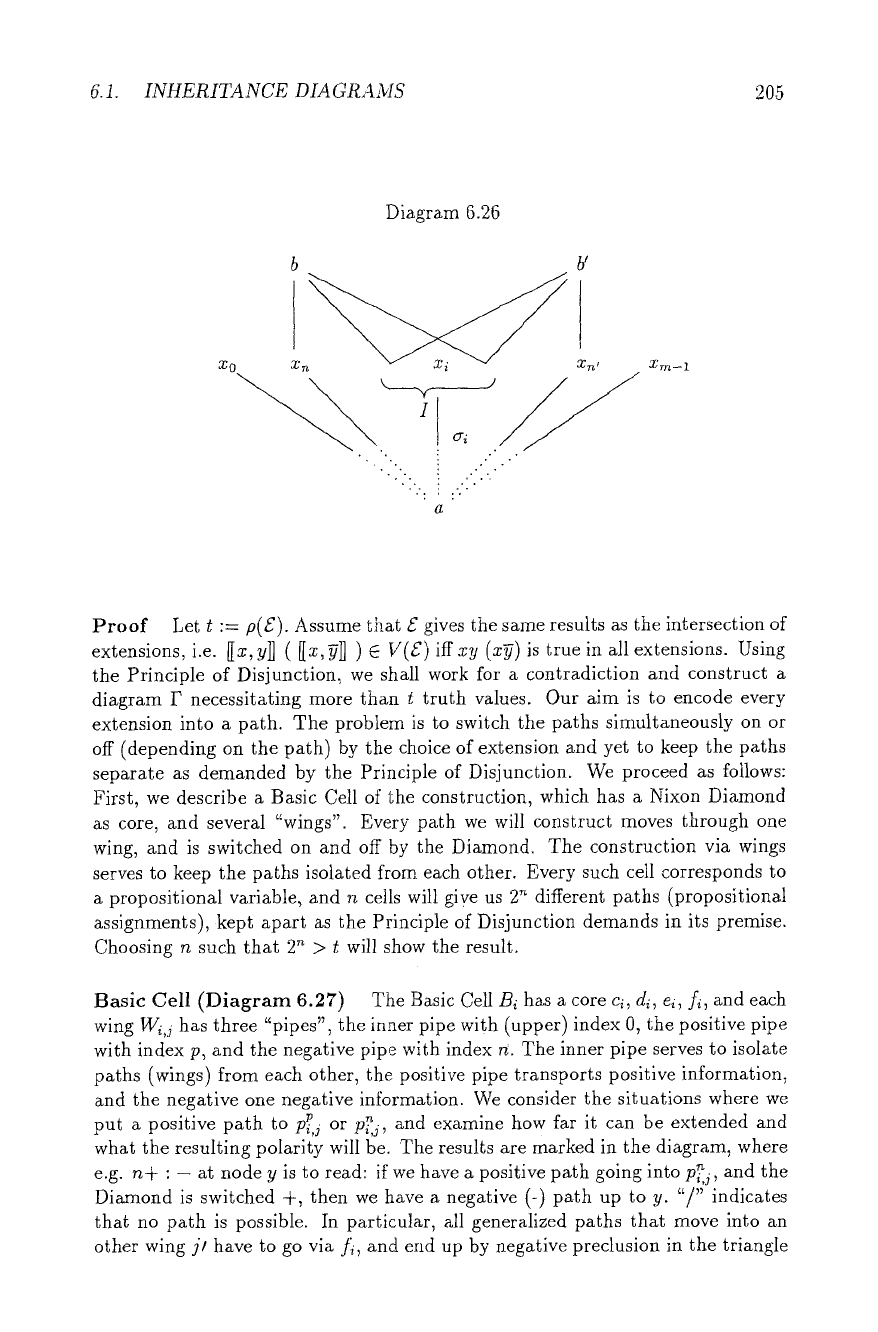
6.1. INHERITANCE DIAGRAMS
205
Diagram 6.26
b b I
X 0 Xr~ Xn~
9 ..).. !
.(.
a
Xrn--1
Proof Let t :=
p(g).
Assume that g gives the same results as the intersection of
extensions, i.e.
~x,y~ ( ~x,~ ) E V($) iff xy (x~) is
true in all extensions. Using
the Principle of Disjunction, we shall work for a contradiction and construct a
diagram F necessitating more than t truth values. Our aim is to encode every
extension into a path. The problem is to switch the paths simultaneously on or
off (depending on the path) by the choice of extension and yet to keep the paths
separate as demanded by the Principle of Disjunction. We proceed as follows:
First, we describe a Basic Cell of the construction, which has a Nixon Diamond
as core, and several "wings". Every path we will construct moves through one
wing, and is switched on and off by the Diamond. The construction via wings
serves to keep the paths isolated from each other. Every such cell corresponds to
a propositional variable, and n cells will give us 2 ~ different paths (propositional
assignments), kept apart as the Principle of Disjunction demands in its premise.
Choosing n such that 2" > t will show the result.
Basic Cell (Diagram 6.27) The Basic Cell
Bi
has a core
cl, di, el, fi,
and each
wing Wi,j has three "pipes", the inner pipe with (upper) index 0, the positive pipe
with index p, and the negative pipe with index n. The inner pipe serves to isolate
paths (wings) from each other, the positive pipe transports positive information,
and the negative one negative information. We consider the situations where we
put a positive path to piP, j
or
pin, j,
and examine how far it can be extended and
what the resulting polarity will be. The results are marked in the diagram, where
e.g. n+ : - at node y is to read: if we have a positive path going into
p~,j,
and the
Diamond is switched +, then we have a negative (-) path up to
y. "/"
indicates
that no path is possible. In particular, all generalized paths that move into an
other wing j! have to go via ]), and end up by negative preclusion in the triangle
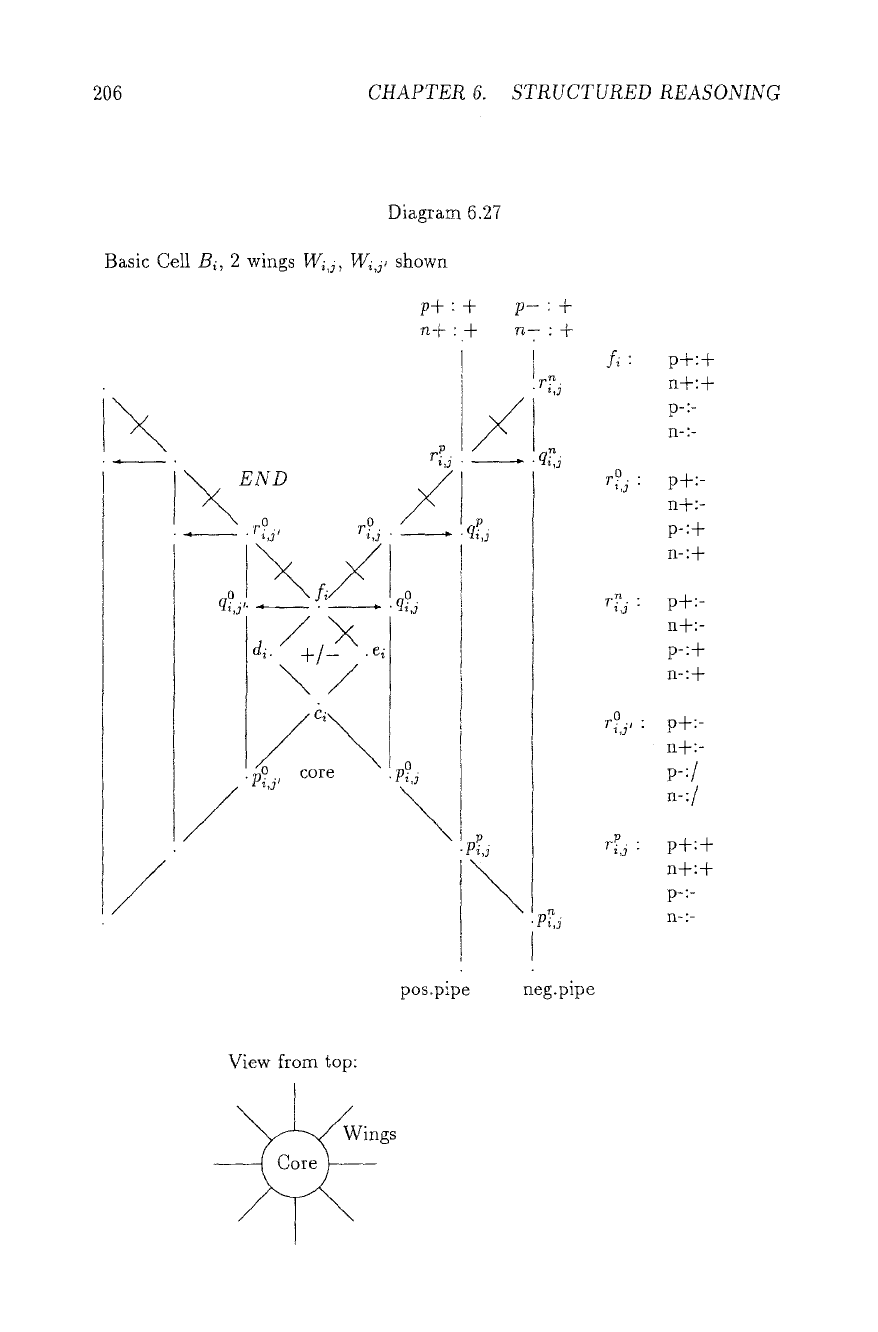
206
CHAPTER 6. STRUCTURED REASONING
Diagram 627
Basic Cell Bi, 2 wings
Wi,j, Wi,j,
shown
>,
Y
S
p+:+
n+ : +
rP.
, o
rg.
,,
F, 3' *o qP3
, . . ' 9 , .
9
oC2
o
9 p{ j, P,,J
p--:+
!
I.
9 Yi, j
9 q~,j
p
9 Pi,d
Pi~j
k :
r 9 .
~,3 :
'rP'. :
roy :
z,2
:
p+:+
n+:+
p-:-
I1-:-
p+:-
n-~:-
p-:+
n-:+
p-l-:-
11+:-
p-:+
n-'@
p+:-
n+:-
p-:/
n-:/
p+:+
n+:+
p-:-
n-:-
pos.pipe neg.pipe
View from top:
@
ings
